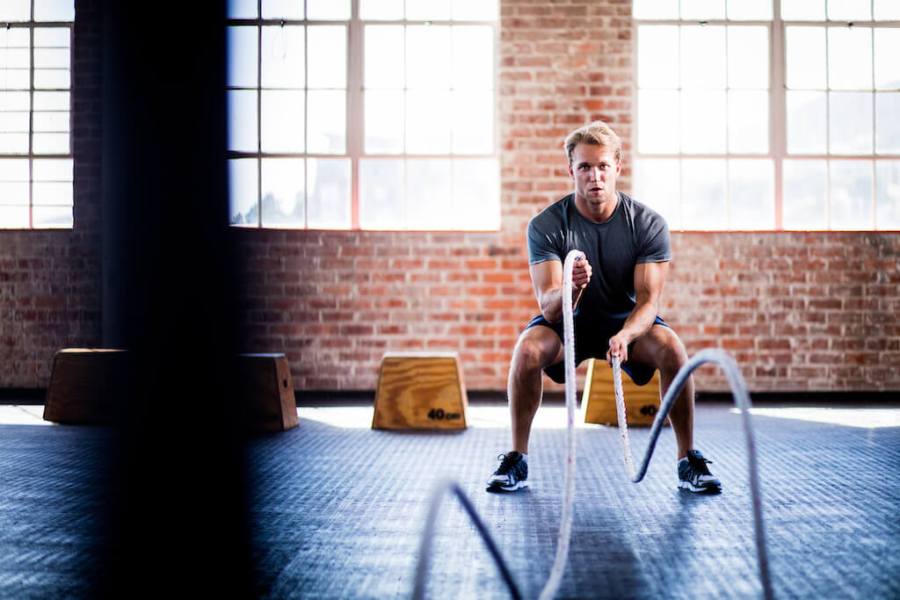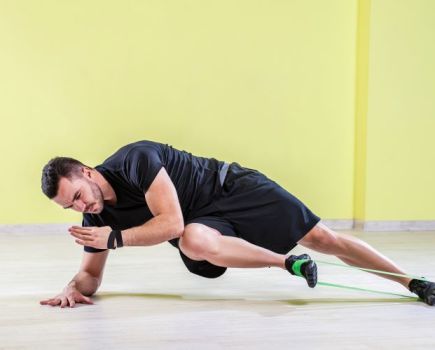Many men who exercise regularly fall into one of two camps: muscle chasers, and endurance enthusiasts. The former enjoy strength training in pursuit of a certain body type; the latter want to be as aerobically fit as possible.
The reality, though, is that to reach your true fitness potential – in or out the gym – you need a healthy balance of both. If you’re a runner, cyclist or swimmer, a stronger physique is going to provide you with the power and resilience to go faster and further, for longer. Equally, if strength training is your primary pursuit, both performance and aesthetics will be hugely improved by having a better engine.
But making cardio integral to your routine will also set you up for a longer, healthier life. “Regular cardio training strengthens your heart and blood vessels, improves your lung capacity, lowers your blood pressure and cholesterol, and reduces your risk of severe diseases,” says Farm Fitness founder Tom Kemp.
Kemp – who’s also an ambassador for PhD Nutrition and its new Life range of supplements – believes in a training approach based around functional movements, calisthenics and, yes, sweaty, heart-pumping cardio run-outs.
Here are his top five tips for making cardio fun again.
View this post on Instagram
1. Do something different
If you’re sick of plodding round the same 5k loop, or staring into the abyss on the cross-trainer, it’s time to inject some energy, variety and intensity into your cardio sessions. One way is to bolt together some favourite gym exercises into a fast-paced circuit.
“Switching up your workouts is a great way to stay motivated,” says Kemp. “You can do AMRAPs (as many rounds as possible) or EMOMs (every minute on the minute), which will really help maintain that intensity in your workouts, and push past the traditional view that you must use one machine for hours on end as your set cardio session.
“You can also try Tabata workouts (20-second efforts followed by 10-second rests, for a total of 4 minutes) or a Chipper workout, which pushes you to ‘chip away’ at every rep of a set workout (in sequence) before you can advance onto the next exercise. It is a prime example of structuring a workout to make it fun and enjoyable.
“All of these varieties allow you to incorporate your favourite exercises and machines to keep things fun.”
2. Push for PBs
Whether you like cycling or circuit training, start giving yourself the same targets as you do in the weights room.
“Setting yourself measurable targets and testing your personal bests is the best way to stay accountable and ensure you’re progressing,” says Kemp. And with new targets to aim for, you won’t have time to get bored.
“Performing some benchmark fitness tests is also a good way to log your progress,” Kemp adds. “Some of my go-to fitness tests include a 10-minute maximum calorie-burn on the assault bike; a 2,000m indoor row; and a 1km run. Keep notes of your previous scores and times and repeat them from time to time to see how you improve. Even just giving yourself a calorie target to aim for on a machine, or a set number of reps for each working minute, can really push you in your workouts.”
3. Join the gang
You may enjoy training alone in the gym, but if you struggle with motivation during your cardio workouts it’s time to team up with other people.
“Incorporating group training into your fitness routine can break up the monotony of stereotypical, solo cardio workouts such as running and cycling,” says Kemp. “Tackling a challenging workout as a team offers group camaraderie and can increase the intensity, as you will be spurred on when surrounded by others.”
There are a growing number of team-based fitness contests you can sign up for, too (obstacle races, team CrossFit events and so on). “Competing with teammates provides a goal to train towards, while improving your cardio fitness levels at the same time,” says Kemp.
View this post on Instagram
4. Head outdoors
Moving your cardio training outside will add extra motivation and rewards – even as the cold begins to bite.
“Aside from the main benefits of training outdoors, such as Vitamin D exposure, fresh air, and a boost of endorphins, being out in the open really helps when a workout gets tough,” insists Kemp. Rather than being in a confined gym space, it makes the workout feel a lot easier and you get to enjoy that feeling of freedom.
“Training outdoors can also give you the flexibility to train in different locations with minimal kit. Take a set of dumbbells, a kettlebell or a sandbag to your local park, or just test yourself with heart-raising bodyweight moves like burpees and squat jumps.”
5. Focus on wellbeing
If you’re struggling with energy or motivation, remember that cardio training will do wonders for your mental health.
“The endorphin buzz from a great workout will motivate anyone’s fitness journey,” says Kemp. “This kind of training improves mental clarity and focus, allowing you to put aside your day-to-day stresses.”
Tough cardio sessions will also help your resolve when you’re back in the weights room or the office. “Cardio can feel uncomfortable and tough,” says Kemp, “which makes it a useful tool for improving mental resilience. Overcoming a killer workout provides a genuine sense of accomplishment.”
Words: Mark Bailey








